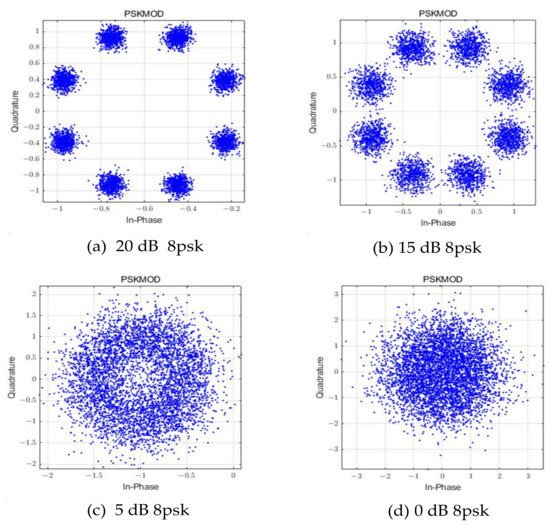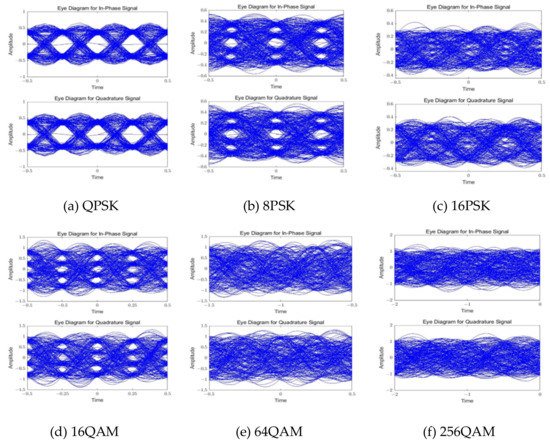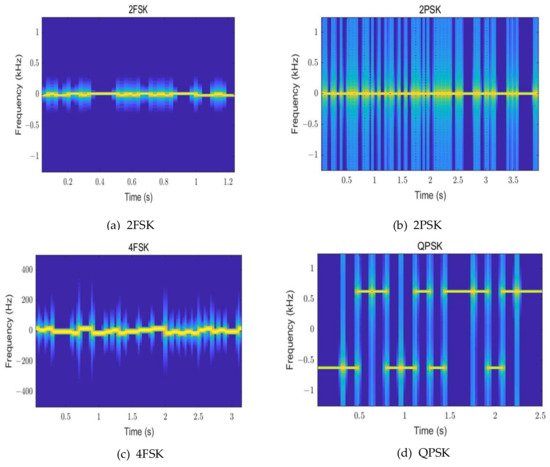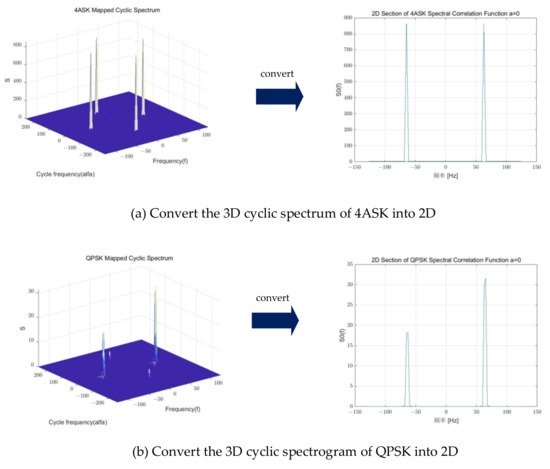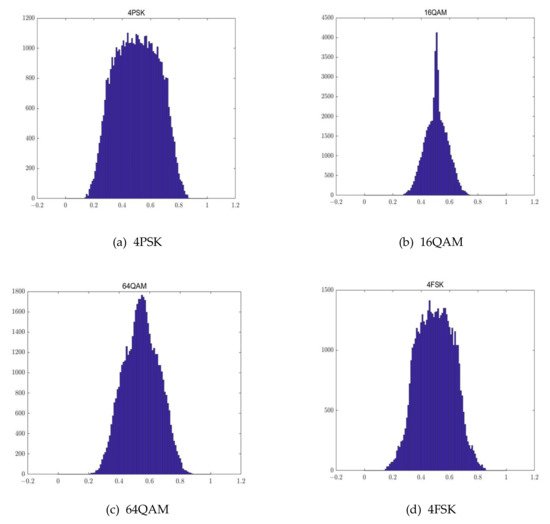深度学习是一种强大的人工智能技术,可以从大量数据中学习特征,拟合非线性网络,因此在计算机视觉、自然语言处理、语音识别等领域得到了广泛的应用,取得了巨大的成功。由于移动通信网络可以非常快地生成大量不同类型的数据,相关研究人员已将深度学习应用于通信领域,为通信技术的发展带来了机遇,例如无线通信中的信号调制,识别可以用深度学习技术来完成,并且基于深度学习的调制识别方法比传统方法具有更好的鲁棒性和更高的准确性。Deep learning is a powerful artificial intelligence technology that can learn features from a large amount of data and fit nonlinear networks, so it is widely used in the fields of computer vision, natural language processing, and speech recognition, and has achieved tremendous success. Since mobile communication networks are able to generate large amounts of different types of data at a very fast pace, relevant researchers have applied deep learning to the field of communication, bringing opportunities for the development of communication technologies. For example, signal modulation identification in wireless communication can be done using deep learning techniques, and deep learning-based modulation identification methods have better robustness than traditional AMR methods and higher accuracy rates. There are many excellent neural networks in deep learning, such as 抗菌素谱分析方法。在深度学习中,有许多优秀的神经网络,如CNN,RNN等。其中,CNN擅长处理图像数据,RNN擅长处理序列信号,因此CNN和RNN在AMR中得到了广泛的应用。我们将在这篇文章中详细介绍神经网络在AMR中的应用。CNN, RNN, etc. Among them, CNN is good at processing image data and RNN is good at processing sequence signals. CNN and RNN are widely used in AMR. The application of these neural networks to deep learning is discussed.
1. 卷积神经网络在调制识别中的应用Application of Convolutional Neural Network in Modulation Recognition
1.1. 卷积神经网络Convolutional Neural Networks
卷积神经网络(The convolutional neural network (CNN)是最流行和最成功的深度学习架构之一,它由多个卷积层、池化层和全连接层组成,其结构图如图) is one of the most popular and successful deep learning architectures, which consists of multiple convolutional layers, pooling layers, and fully connected layers, and its structure diagram is shown in Figure 1所示。其中,卷积层可以提取输入数据的不同特征,池化层可以对卷积后的高维特征进行降级以提高计算速度,全连接层可以将先前提取的局部特征组合成全局特征,最终根据特征完成分类。. Among them, the convolutional layer can extract different features of the input data, the pooling layer can downscale the high-dimensional features after convolution to improve the computation speed, and the fully connected layer can combine the previously extracted local features into global features and finally complete the classification according to the features.
图Figure 1.卷积神经网络结构。 Convolutional neural network structure.
CNN是图像处理的理想选择,因为它可以使用卷积从图像中准确地提取特征信息。因此,学者们在识别调制信号的类型时,通常会将信号处理成星座图、时频图等二维图像,然后利用卷积层从图像中提取信号的特征,分类由全连接层完成。另一方面, is ideal for image processing because it can accurately extract feature information from images using convolution. Therefore, when identifying the type of the modulated signal, scholars usually process the signal into two-dimensional images such as constellation diagrams and time-frequency diagrams, then use convolutional layers to extract the features of the signal from the image, and the classification is done by the fully connected layer. On the other hand, CNN也广泛用于文本和信号,因此许多学者使用CNN直接从信号中提取特征。 is also widely used in text and signals, so many scholars use CNN to directly extract features from signals.
1.2. 基于卷积神经网络的调制识别方法The Modulation Recognition Method Based on Convolutional Neural Network
- 1.
-
一种基于A two-dimensional image recognition method based on CNN
的二维图像识别方法.
-
将信号转换为Converting the signal to a 2D图像,然后使用CNN识别调制是非常流行的,因此我们将在本节中介绍这种方法。 image and then using a CNN to identify the modulation is very popular, so researchers will introduce this method in this section.
((1) 星座图) Constellation map
星座图是对信号投影到正交矢量空间的图形见解,其维度由特定的调制类型决定。二维星座图是迄今为止最常见的,它可以反映不同调制类型的不同特征。本文显示了图7中A constellation diagram is a graphical insight into the projection of a signal into an orthogonal vector space, the dimensionality of which is determined by the specific type of modulation. Two-dimensional constellation diagrams are by far the most common, which can reflect different characteristics of different modulation types. This paper shows the constellation diagram of the 8PSK信号在 signal at 20 dB、15 dB、5 dB和0 dB下的星座图。从图, 15 dB, 5 dB, and 0 dB in Figure 2. It can be seen from Figure 2可以看出,星座图的特征在高信噪比下比较明显,在低信噪比下不太明显。因此,一些学者会将单通道星座图转换为三通道彩色星座图,以提高识别率,从而可以达到更好的效果,因此星座图经常用于调制识别。 that the features of the constellation diagram are more obvious under high signal-to-noise ratio and less obvious under low signal-to-noise ratio. Therefore, some scholars will convert the single-channel constellation diagram into a three-channel color constellation diagram to increase the recognition rate, which can achieve better results, so constellation diagrams are often used in modulation identification.
图Figure 2.不同信噪比下 Constellation diagram of 8PSK的星座图。 under different signal-to-noise ratios.
彭胜利等Shengliang Peng et al.
[1]将复杂信号转换为星座图,并将两种流行的 converted complex signals into constellation maps and applied two popular CNN
模型( models (AlexNet
和谷歌网络)应用于复杂信号的识别,并设计了基于CNN的调制识别算法。最后,实验表明,当信噪比大于6 dB时,该算法对8种调制信号的识别率达到95%以上,优于传统的支持向量机。但是,当信噪比小于1 dB时,模型的识别精度小于80%。可以看出,低信噪比下的识别精度有待提高。 and GoogleNet) to the recognition of complex signals and designed a CNN-based modulation recognition algorithm. Finally, experiments showed that when the signal-to-noise ratio is greater than 6 dB, the recognition rate of the algorithm for eight kinds of modulation signals reaches more than 95%, which is better than the traditional support vector machine. However, when the signal-to-noise ratio is less than 1 dB, the recognition accuracy of the model is less than 80%. It can be seen that the recognition accuracy under low signal-to-noise ratio needs to be improved.
为了提高识别分类的准确性,田旭In order to improve the recognition classification accuracy, X. Tian [2]将星座图处理为带有彩色阴影的热图。然后,使用典型的 processed the constellation map into a heat map with colored shadows. Then, the typical CNN
模型,即VGG16,VGG19, model is used, namely VGG16, VGG19, InceptionV3
,, Xception
和, and ResNet50
来识别六种调制方法的星座热图。其中, to identify the constellation heatmaps of six modulation methods. Among them, ResNet50
具有最佳的分类精度,准确率可以达到95%以上。然而,当信噪比降至2 dB时,识别精度降至80%,因此该方法仅适用于高信噪比环境。 has the best classification accuracy, and the accuracy rate can reach more than 95%. However, when the signal-to-noise ratio drops to 2 dB, the recognition accuracy drops to 80%, so this method is only suitable for high signal-to-noise ratio environments.
由于缺乏对Due to the lack of relevant research on DL-based AMR in MIMO-OFDM
系统中基于DL的AMR的相关研究,作者 systems, the authors of [3]针对 proposed a series of constellation multimodal feature networks (SC-MFNet) for the modulation recognition problem of MIMO-OFDM
系统的调制识别问题,提出了一系列星座多模态特征网络( systems in their work. The SC-MFNet
)。SC-MFNet网络由四部分组成,包括基于 network has four parts, including the feature extraction module based on Conv1DNe
t的特征提取模块、基于高效网络的星座特征提取模块、多模态特征融合模块和全连接分类器。作者将5个调制信号(BPSK、QPSK、8PSK、t, the constellation feature extraction module based on efficient network, the multimodal feature fusion module, and the full connection classifier. The authors input the waveform diagrams of the five modulated signals (BPSK, QPSK, 8PSK, 16 QAM
和, and 32 QAM
)的波形图和分段累积星座图输入到) and the segmented accumulated constellation diagrams into the SC-MFNet
网络中,网络提取信号波形图和星座图的特征,并融合特征。最终分类实验表明,当信噪比为0 dB时, network, and the network extracts the features of the signal waveform diagrams and constellation diagrams and fuses the features. Final classification experiments show that the SC-MFNet
的识别精度为95%。 has a recognition accuracy of 95% when the signal-to-noise ratio is 0 dB.
((2) 眼图) Eye diagram
眼图是由示波器上累积的一系列数字信号显示的波形,可以反映数字信号的整体特性。不同调制信号的眼图特性不同,因此可以将信号转换为眼图,然后利用深度学习网络模型提取眼图中的特征,完成调制识别。将调制信号转换为眼图是调制识别过程中的重要步骤。复习文献后,最常用的转换方法有三种:一是使用示波器专用的眼图生成模块将调制信号转换为相应的眼图The eye diagram is a waveform displayed by a series of digital signals accumulated on the oscilloscope that can reflect the overall characteristics of the digital signal. The eye diagram characteristics of different modulation signals are different, so the signal can be converted into an eye diagram, and then the deep learning network model is used to extract the features in the eye diagram to complete modulation recognition. Converting the modulation signal into an eye diagram is an important step in the modulation identification process. After reviewing the literature, there are three most commonly used conversion methods: The first is to use the dedicated eye diagram generation module of the oscilloscope to convert the modulated signal into the corresponding eye diagram [4];
二是使用 the second is to use the eye diagram function in MATLAB
中的眼图功能生成眼图;第三是研究人员需要编写自己的程序来完成眼图的转换。由于眼图本身是由示波器的余辉效应生成的,因此上面提到的第一种方法在生成眼图时会更准确。由于实验条件的限制,本文利用 to generate the eye diagram; and the third is that researchers need to write their own programs to complete the conversion of the eye diagram. Since the eye diagram itself is generated by the afterglow effect of the oscilloscope, the first method mentioned above will be more accurate when generating the eye diagram. Due to the limitations of experimental conditions, this paper uses the eye diagram function in MATLAB
中的眼图功能将QPSK、8PSK、16PSK、4QAM、16QAM和 to convert QPSK, 8PSK, 16PSK, 4QAM, 16QAM, and 256QAM
信号转换为眼图,如图 signals into eye diagrams, as shown in Figure 3所示。.
Figure 3. Eye diagram of modulated signals.
The authors of
[5] demonstrated preliminary results of deep learning for modulation identification through eye diagrams of signals. The paper first convolves the I and Q eye maps of the signal, secondly connects the I and Q eye maps, then performs maximum pooling, and finally experimentally verifies that the model can achieve a 100% recognition rate for OQPSK as well as BPSK. The recognition rate of 16 QAM is less than 80%.
The authors of
[6] considered that the original eye diagram did not consider the signal aggregation degree at a specific position, so they enhanced the eye diagram. The authors use the enhanced signal eye diagram as the input to the neural network, and then extract and map features of different dimensions using a multi-input CNN model. Experiments show that the recognition accuracy of the model for BPSK, QPSK, OQPSK, 8PSK, and 16APSK is close to 100% at 2 dB, but the recognition accuracy for 64 QAM, 32 QAM, and 16 QAM is low. Therefore, it is necessary to further improve the intraclass recognition of modulated signal accuracy.
Dan. W et al.
[4] proposed a CNN-based optical signal modulation recognition and classification algorithm. The author uses the eye pattern generation module of the oscilloscope to generate four modulated optical signals (return-to-zero on-off keying (RZ-OOK), non-return-to-zero keying (NRZ-OOK), RZ-differential phase shift keying (RZ-DPSK), and four-pulse amplitude modulation (4PAM) are converted into eye diagrams, and then CNN is used to learn the features of the eye diagrams and complete the classification. The recognition rate of the four modulation methods is close to 100%.
(3) Time-frequency diagram
If only the characteristics of the signal in the time and frequency domains are analyzed, the characteristics of the signal may be lost. Therefore, to observe the relevant characteristics of the signal more thoroughly, scholars will perform time-frequency analysis of the signal, such as using wavelet transform and other methods, such as converting the signal to a time-frequency map and extracting the features from the time-frequency map. Therefore, it is also a popular method to use deep learning to extract time-frequency map features to complete modulation recognition. WResearchers have drawn the time-frequency diagrams of 2FSK, 4FSK, 2PSK, and 4PSK signals in Figure 4, and wresearchers can see that different modulation signals have different time-frequency diagrams.
Figure 4. Time-frequency diagram of modulation signal.
The authors of
[7] used neural networks to process time-frequency images of radar signals to identify the modulation types of radar signals. This paper first uses complex wavelet transform to obtain the time-frequency image of the signal, and then uses image cropping, grayscale, adaptive filter normalization, and other steps to enhance the time-frequency image. The results show that when the signal-to-noise ratio is −7 dB, the recognition rate reaches more than 92%, which fully proves that the time-frequency diagram of the signal can well reflect the characteristics of the modulated signal. The author also proposed the Sep-ResNet model for recognition. After comparison, the Sep-ResNet model is better than the ResNet50 and VGG networks.
The authors of
[8] proposed an LPI radar signal recognition method based on dual-channel CNN and feature fusion. The authors used the wavelet transform method to convert the signal into a time-frequency map, and the time-frequency map was processed in grayscale. Subsequently, it was inputted into the two-channel CNN model, which can extract two features, the oriented gradient (HOG) and the depth feature histogram, from the signal time-frequency map and finally fuse the two features and classify them. The classification method has a signal-to-noise ratio of 6 dB, and the recognition rate can reach more than 95%.
The authors of
[9] proposed a modulation and identification method of impulse noise communication signals based on fractional low-order Choi–Williams distribution and CNN, aiming at the low recognition rate of a communication signal in non-Gaussian noise. Feature extraction was performed, and then FLO-CWD used to transform the signal time-frequency map by inputting the transformed time-frequency map into the improved CNN for the second feature extraction and classification. The recognition rate of this method reaches 95% at 4 dB. However, this method only recognizes signals of 2ASK, 2FSK, and 2PSK modulation methods and does not know the recognition rate of other modulation methods. Therefore, if
wresearche
rs want to apply this method to actual communication systems,
weresearchers need to continue research and optimization.
(4) Circulation spectrogram
A cyclic spectrum has good anti-noise performance, so it is often used to analyze signals in environments with large noise interference. The 3D graph output by the cyclic spectrum can give an intuitive impression, and the signal can be further analyzed by the cross-sectional view of the 3D graph in different directions. In order to further visualize the cyclic spectrogram of the modulated signal, this paper uses MATLAB to draw the three-dimensional cyclic spectrogram of QPSK and 4ASK and intercept the two-dimensional part when the cyclic frequency alpha is equal to 0, as shown in Figure 5.
图Figure 5. Graphical construction of QPSK 和and 4ASK 信号的图形构造。signals.
In 2019
年,作者, the author of [10]针对星座图在低信噪比下性能差、识别率低、适应阶段差等问题进行了改进,提出了一种基于创新 made improvements to address the poor performance of constellation maps at low signal-to-noise ratios, resulting in low recognition rates and poor adaptation phases, and proposed a modulation recognition method based on innovative CNN
和递归频谱图的调制识别方法。笔者首先将信号的三维循环频谱映射为二维,再以二维循环频谱为数据集。然后使用改进的CNN来提取循环频谱的特征。最后,软最大层用于成功识别8种调制模式。s and recurrent spectrograms. The author first maps the three-dimensional cyclic spectrum of the signal into two dimensions, and then takes the two-dimensional cyclic spectrum as the dataset. Then the improved CNN is used to extract the features of the cyclic spectrum. Finally, the softmax layer is used to successfully identify eight modulation modes.
作者The authors of [11]提出采用深度学习算法对信号进行循环频谱图处理,以识别二次调制信号。作者使用 proposed using a deep learning algorithm to process the cyclic spectrogram of the signal to identify the secondary modulation signal. The author uses AlexNet
、vgg16、vgg19 和, vgg16, vgg19, and resnet18
来识别七个调制信号(蓝牙、QPSK、2FSK、无线频谱、二方点和 to recognize the two-dimensional cyclic spectrum images of seven modulated signals (BPSK, QPSK, 2FSK, bpsk-pm, qpsk-pm, 2fsk-pm, and DS-BPSK
)的二维循环频谱图像。实验结果表明,VGG19和). The experimental results show that the recognition accuracy of VGG19 and ResNet18
的识别精度较高,但 is better, but the confusion rate of BFSK-PM
和 and BPSK-PM
的混淆率较高。 is high.
((5) 振幅直方图) Amplitude Histogram
信号的振幅直方图可以表示信号的幅度与不同振幅的采样点数之间的关系。不同调制方法的幅度直方图差异较大,如图The amplitude histogram of the signal can represent the relationship between the amplitude of the signal and the number of sampling points of different amplitudes. The amplitude histograms of different modulation methods have large differences, as shown in Figure 6所示,说明不同调制方法的幅度直方图都是不同的形状。, which shows that the amplitude histograms of different modulation methods are all different shapes.
图Figure 6.调制信号的幅度直方图。 Amplitude histogram of modulated signal.
作者The authors [12],提出了, proposed a new scheme of CNN
的新方案。基于信号幅度直方图的联合OSNR监测和MFI。笔者利用常模算法(CMA)在均衡后得到调制信号样本,绘制振幅直方图(Ahs),然后利用卷积神经网络一种基于VGG的设计,提取振幅直方图的特征进行分类和识别。经过2500次训练,QPSK、8-QAM、16QAM的识别率达到100%,说明CNN可以根据信号的直方图识别信号的调制类型。. Joint OSNR monitoring and MFI based on the signal amplitude histogram. The author uses the constant modulus algorithm (CMA) to obtain modulated signal samples after equalization to draw amplitude histograms (Ahs), and then uses the convolutional neural network a design based upon VGG to extract the features of the amplitude histograms for classification and identification. After 2500 times of training, the recognition rate of QPSK, 8-QAM, and 16QAM reached 100%, indicating that CNN can identify the modulation type of the signal according to the histogram of the signal.
作者The authors [13]提出了一种基于通信信号循环累积的多层神经网络调制模式识别方法。作者使用改进的 proposed a multi-layer neural network modulation pattern recognition method based on cyclic cumulants of communication signals. The authors use the improved CNN
提取MPSK和MQAM循环频谱图中表示的信号特征,然后使用软最大层完成分类。该算法在 to extract the signal features represented in the cyclic spectrograms of MPSK and MQAM, and then use the softmax layer to complete the classification. The algorithm can achieve a recognition accuracy of 92% in a signal-to-noise ratio environment of −5~5 dB
的信噪比环境中可实现92%的识别精度。.
- 2.
-
一种基于The signal sequence recognition method based on CNN
的信号序列识别方法.
-
除了基于In addition to the CNN的信号二维图像识别方法外,一些学者还利用CNN直接提取信号序列中的特征并完成分类。因此,本节将介绍基于CNN的信号序列识别方法。-based signal two-dimensional image recognition method, some scholars use CNN to directly extract the features in the signal sequence and complete the classification. Therefore, this section will introduce the CNN-based signal sequence recognition method.
((1) 智商序列) IQ sequence
S. Hong
等人提出了一种基于 et al. proposed a DL
的AMR算法来识别正交频分复用(OFDM)系统中的信号-based AMR algorithm to identify signals in Orthogonal Frequency Division Multiplexing (OFDM) systems [14].
作者使用卷积神经网络来训练 The authors used convolutional neural networks to train IQ samples of OFDM
信号的智商样本。通过实验可以看出,当信噪比为10dB时,正确分类概率高于90%,但当信噪比低于10dB时,识别精度迅速下降。 signals. It can be seen through experiments that when the signal-to-noise ratio is 10dB, the correct classification probability is higher than 90%, but when the signal-to-noise ratio is lower than 10dB, the recognition accuracy drops rapidly.为了使In order to enable CNN
能够处理少量数据,作者 to work with a small amount of data, the authors of [15]提出了一种数据增强调制识别方法。作者首先根据输入 proposed a data-augmented modulation recognition method. The authors first calculate the amplitude, phase, and frequency according to the input IQ
信号计算幅度、相位和频率,并将其作为最基本的信号特征。其次,根据星座图中调制信号的分布重新排列信号的相序,从而获得新的特征。然后,获得信号的高阶光谱信息,以提供新的识别线索。最后,将IQ信号、信号的振幅频率相位、重序IQ序列、重序幅度频率相位、信号的高阶频谱输入到改进的CNN中进行分类和识别。实验结果表明,该算法的平均识别率达到95%以上。但是,这种方法的特征提取过程相对复杂,不利于其在多变的通信环境中的使用。禹。W等人将基于DL的AMR算法应用于多输入多输出(MIMO)系统,并在他们的工作中 signal, and take them as the most basic signal features. Second, the phase sequence of the signals is rearranged according to the distribution of the modulated signals in the constellation diagram, so as to obtain new features. Then, the higher-order spectral information of the signal is obtained to provide new identification clues. Finally, the IQ signal, the amplitude frequency phase of the signal, the reordered IQ sequence, the reordered amplitude frequency phase, and the high-order spectrum of the signal are input into the improved CNN for classification and identification. The experimental results show that the algorithm achieves an average recognition rate of above 95%. However, the feature extraction process of this method is relatively complicated, which is not conducive to its use in a changeable communication environment. Yu. W et al. applied the DL-based AMR algorithm to multiple-input multiple-output (MIMO) systems, and in their work [16]他们提出了一种基于 they proposed a CNN
的零强迫 (ZF) 均衡 AMR 方法。其中,采埃孚均衡可以提高信道状态信息(CSI)下接收信号的信噪比,提高调制辨识的准确性。因此,作者将接收到的信号和CSI输入到采埃孚均衡中,进行矢量化,最后将它们输入到CNN中进行分类。通过实验可以看出,当信噪比为5 dB时,基于CNN的采埃孚均衡AMR算法的识别精度达到90%以上,优于基于ANN和高阶累积的传统算法。胡恩-泰等人-based zero-forcing (ZF) equalization AMR method. Among them, ZF equalization can improve the signal-to-noise ratio of the received signal under the channel state information (CSI) and enhance the accuracy of modulation identification. Therefore, the author inputs the received signal and CSI into ZF equalization, performs vectorization, and finally inputs them into CNN for classification. Through experiments, it can be seen that the recognition accuracy of the ZF equalization AMR algorithm based on CNN reaches more than 90% when the signal-to-noise ratio is—5 dB, which is better than the traditional algorithm based on ANN and higher-order cumulants. Huynh-The et al. [17]提出了一种三维 proposed a three-dimensional MIMO-OFDM
卷积神经网络(MONet),能够在多输入多输出正交频分复用( Convolutional Neural Network (MONet) capable of accomplishing efficient AMR in a Multiple-Input Multiple-Output Orthogonal Frequency Division Multiplexing (MIMO-OFDM
)系统中实现高效的AMR。天线内部和天线之间的相关底层特征可以通过网络的立方卷积滤波器在多尺度信号下提取。通过实验仿真,MONet在0 dB的条件下可以达到95%的识别精度。) system. The relevant underlying features within and between antennas can be extracted under multi-scale signals through the cubic convolution filter of the network. Through experimental simulation, MONet can achieve 95% recognition accuracy under the condition of 0 dB.
((2) 高阶累积物) Higher-order cumulants
早在Research on signal modulation identification based on higher-order cumulants was carried out as early as 1992
年就进行了基于高阶累积体的信号调制识别研究,当时作者, when the author [18]使用高阶累积物作为相关特征,并使用决策树做出判断,从而识别调制模式。随后,许多学者开始使用高阶累积物作为调制分类的特征。 used higher-order cumulants as relevant features and used decision trees to make judgments, resulting in the identification of modulation patterns. Subsequently, many scholars began to use high-order cumulants as features for modulation classification [19][20][21]并取得了良好的效果。深度学习发展后,一些学者将深度学习与高阶累积算法相结合,研究了一种新的 and achieved good results. After the development of deep learning, some scholars combined deep learning with high-order cumulants to study a new AMR
算法。 algorithm.
王毅提出了一种基于Y. Wang proposed a CNN
的一氧化碳AMR方法-based CO-AMR method [22].
作者使用 The author used CNN
提取所有天线数据集中信号的高阶累积特征,并识别子结果。将所有子结果合并,最后使用决策规则(直接投票和加权投票)完成分类。实验表明,当信噪比大于0 dB时,算法的识别精度可以达到100%,但在−5 dB时,识别率仅为82%。因此,有必要进一步提高低信噪比下的识别率。 to extract the high-order cumulant features of the signal in all antenna datasets and identify sub-results. All sub-results were combined, and finally, using decision rules (direct voting and weighted voting) to complete the classification. Experiments showed that when the signal-to-noise ratio is greater than 0 dB, the recognition accuracy of the algorithm can reach 100%, but at −5 dB, the recognition rate is only 82%. Therefore, it is necessary to further improve the recognition rate under a low signal-to-noise ratio.
从以上文献调查可以看出,由于From the above literature survey, it can be seen that because CNN更适合从图像中提取信息,因此关于利用CNN直接提取信号序列特征的研究并不多。相对而言,RNN直接从信号序列中提取特征的能力比CNN更强。因此,本文将在下一节中介绍基于RNN的调制识别算法。 is more suitable for extracting information from images, there are not many studies on using CNN to directly extract signal sequence features. Relatively speaking, the ability of RNN to extract features directly from the signal sequence is stronger than that of CNN. Therefore, this paper will introduce the modulation recognition algorithm based on RNN in the next section.
2. 递归神经网络在调制识别中的应用Application of the Recurrent Neural Network in Modulation Recognition
2.1. 递归神经网络Recurrent Neural Networks
递归神经网络Recurrent Neural Networks (RNN) 与具有前馈连接的典型多层网络不同。RNN 通过递归连接的概念进行扩展,以将信息反馈到前一层(或同一层)。其结构如图(RNNs) are different from typical multi-layer networks with feedforward connections. RNNs are extended by the concept of recursive connections to feedback information to the previous layer (or the same layer). Its structure is shown in Figure 7所示。. The input of the RNN
的输入是不同时刻的数据。首先,信息将从信号的那一刻开始输入。输入门决定此时刻的信息是否输入到记忆神经元中。输出门决定是否输出此时刻的信息。遗忘之门决定了这一刻的信息是否被遗忘。如果不忘记,可以将其传输到下一刻,并循环该过程,直到处理整个输入信号。根据上述特点,可以知道is the data of different moments. Firstly, the information will be input from the moment of the signal. The input gate decides whether the information of this moment is input into the memory neuron. The output gate decides whether the information of this moment is output. The forgetting gate decides whether the information of this moment is forgotten. If it is not forgotten, it can be transmitted to the next moment, and the process is cycled until the whole input signal is processed. According to the above characteristics, it is known that RNN
非常擅长处理序列信号,如时间序列、文本序列、音频数据等。 is very good at processing sequence signals, such as time series, text sequences, and audio data [23].
通信信号是随时间变化的信号,因此一些学者开始使用 The communication signal is a signal that changes with time, so some scholars began to use RNN
来处理通信信号 to process the communication signal [24].
因此,本节介绍 Therefore, this section presents the application of RNN
在调制识别中的应用。 in modulation recognition.
图Figure 7.循环神经网络的结构图。 Structure diagram of cyclic neural network.
2.2. Modulation Recognition Based on Recurrent 基于递归神经网络的调制识别Neural Network
自动调制识别工作非常依赖于信号的特性。对于不同类型的特征,提取和分类方法也不同。在之前的内容中提到,使用The automatic modulation recognition work is very dependent on the characteristics of the signal. For different types of features, the extraction and classification methods are also different. It is mentioned in the previous content that with CNN
更容易提取信号的二维图像中的特征,但对于其他形式的特征,CNN的提取和分类效果就不那么好了。例如,雷达信号中的脉冲重复间隔(PRI)特征不利于使用CNN进行提取和分类,因为信号的PRI将极大地阻碍CNN的在线应用 it is easier to extract the features in the two-dimensional image of the signal, but for other forms of features, the extraction and classification effect of CNN is not so good. For example, pulse repetition interval (PRI) features in radar signals are not conducive to extraction and classification using CNN, because the PRI of the signal will greatly hinder the online application of CNN [25].
随后,一些学者证明, Subsequently, some scholars proved that the LSTM
模型可以比CNN模型更好地提取PRI特征。 model can extract PRI features better than the CNN model [26].
In 2020
年,作者, the authors of [27]针对, taking into account the sequence characteristics of PRI
的序列特性,提出了一种将注意机制与GRU相结合的模型,用于识别雷达信号的调制类型。该模型可以在存在高比例的缺失和杂散脉冲的情况下提高识别率。本文建议使用单热向量来表示PRI序列,然后减小序列的维数并将其输入到基于注意力的GRU模型中,这可以保存PRI序列中包含的顺序模式,最后通过GRU输出。本文建议使用单热向量来表示PRI序列,然后减小序列的维数并将其输入到基于注意力的GRU模型中,这可以保存PRI序列中包含的顺序模式,最后通过GRU输出。, proposed a model combining attention mechanism with GRU to identify the modulation type of radar signal. The model can improve the recognition rate in the presence of a high ratio of missing and spurious pulses. This article proposes to use a one-hot vector to represent the PRI sequence and then reduce the dimensionality of the sequence and input it into the attention-based GRU model, which can save the sequential patterns contained in the PRI sequence and finally output it through the GRU. This article proposes to use a one-hot vector to represent the PRI sequence and then reduce the dimensionality of the sequence and input it into the attention-based GRU model, which can save the sequential patterns contained in the PRI sequence and finally output it through the GRU.
受Inspired by the fact that the nodes of the potential layer in the LSTM
模型中势层节点能够保留信息的动态时域特性的启发,一些学者提出了一种基于LSTM的低信噪比调制识别方法。 model can retain the dynamic time-domain characteristics of the information, some scholars proposed a low SNR modulation recognition method based on LSTM [28].
这项工作使用 This work uses an LSTM
网络来构建信噪比分类器,去噪自动编码器,最后是识别分类器。信噪比分类器由三层LSTM层和一个全连接层组成,可根据设定的阈值将信号分为低信噪比信号和高信噪比信号。去噪自动编码器由五个双向LSTM层组成,可以对信噪比低的信号进行去噪。最后,设计了一种基于LSTM的调制识别结构。实验结果表明,基于LSTM的调制识别模型在信噪比为 network to construct a signal-to-noise ratio classifier, a denoising auto-encoder, and finally a recognition classifier. The signal-to-noise ratio classifier consists of three LSTM layers and a fully connected layer, which can divide the signal into low signal-to-noise ratio signals and high signal-to-noise ratio signals according to the set threshold. The denoising auto-encoder is composed of five bidirectional LSTM layers, which can denoise signals with a low signal-to-noise ratio. Finally, a modulation recognition structure based on LSTM is designed. The experimental results show that the modulation recognition model based on LSTM can achieve an average recognition rate of more than 90% at a signal-to-noise ratio of 0~8 dB
时,平均识别率可达90%以上,但信噪比为, but the recognition rate is still low with a signal-to-noise ratio of −10 dB~−2 dB
时识别速率仍然很低。.
S. Wei
等人使用结合自我注意机制和双向 et al. used a model combining a self-attention mechanism and bidirectional LSTM
的模型来识别雷达信号的调制模式。 to identify the modulation mode of a radar signal [29].
该方法在低信噪比下可准确识别8类雷达调制信号, The method can accurately identify eight types of radar modulation signals under low signal-to-noise ratio and the recognition rate is as high as 95% at −10 dB
时识别率高达95%。实验表明,该模型的识别精度优于中国人类发展网络、德尔肯网络、赛克-CNN和赛克网络。景庆峰等. Experiments show that the recognition accuracy of the model is better than CLDN, DRCNN, Seq-CNN, and Seq-Res networks. Qingfeng Jing et al.
[30]设计了一种基于 designed an end-to-end modulation identification method based on LSTM
和GRU的端到端调制辨识方法,可直接从采样信号中获取调制类型。实验结果表明,笔者提出的端到端调制识别方法,每种类型的调制信号都能达到90%的识别率。为了解决 CNN 和 RNN 在提取信号特征时的局部依赖性约束, and GRU, which can directly obtain the modulation type from the sampled signal. The experimental results show that the end-to-end modulation recognition method proposed by the author can achieve a recognition rate of 90% for each type of modulated signal. In order to solve the local dependency constraints of CNN and RNN in extracting signal features, W. Kong
等人提出了一种基于变压器的连接顺序神经网络结构 (ctdnn)et al. proposed a transformer based connected sequential neural network structure (ctdnn) [31].
首先,笔者利用卷积层将信号的时域序列映射到高维空间,然后利用变压器编码器完成信号的特征提取,最后利用全连接层完成信号分类。实验表明,该模型能很好地完成 First, the author uses the convolution layer to map the time-domain sequence of the signal to a high-dimensional space, then uses the transformer encoder to complete the feature extraction of the signal, and finally uses the fully connected layer to complete the signal classification. Experiments show that the model can complete the classification of 10
个调制信号的分类。 modulated signals well.本文总结了过去This paper summarizes the last 5年基于RNN的调制辨识方法,见表 years of RNN-based modulation identification methods in Table 1。由于. Since it is easier for the RNN更容易从序列信号中提取信息,因此将信号的IQ序列输入到RNN中进行识别更有利于提高识别精度。 to extract the information from the sequence signal, inputting the IQ sequence of the signal into the RNN for identification is more conducive to improving the identification accuracy.
According to the previous description, CNN
具有很强的图像信息处理能力, has a strong ability to process image information, and RNN
在直接处理IQ信号时具有出色的性能。因此,一些学者将CNN和RNN结合起来,形成了CLDNN模型。 has excellent performance when processing IQ signals directly. Therefore, some scholars combined CNN and RNN to form the CLDNN model [41],而, and CLDNN
充分发挥了这两种模式的优势,进一步提高了调制识别的精度。此后,越来越多的学者致力于研究组合神经网络在调制识别中的应用。在本节中,我们总结了基于组合网络的调制识别方法。
T. Wang proposed an MCF network composed of the Information Cue Multi-Stream Module (SCMS
)和视觉提示识别模块() and the V
CD)组成的MCF网络。isual Cue Recognition Module (VCD) [42].
网络实现了信号的 The network realizes the parallel feature extraction of the IQ
、AΦ和信号星座的并行特征提取。SCMS模块提取IQ信号和AΦ信号的特征,并使用VCD从星座中提取信号的特征。最后,对提取的特征进行融合和分类。作者在实验过程中将主频网络与, AΦ, and signal constellation of the signal. The SCMS module extracts the features of the IQ signal and the AΦ signal and uses the VCD to extract the features of the signal from the constellation. Finally, the extracted features are fused and classified. The author compared the MCF network with CM+CNN
、高新网、低频闪和长联网络模型进行了比较。结果表明,MCF网络的识别精度更高。当信噪比大于0 dB时,识别精度接近100%。
The authors of [43]提出了一个新的基于深度学习的注意力协作框架,其中包括 proposed a new deep learning-based attention collaboration framework, which includes CNN
,RNN和GAN网络。其中,采用ACGAN对原始数据进行扩展,然后分别利用CNN和RNN提取信号的时空特征。最后,使用GAMP融合信号的空间和时间属性,并使用完全连接的层进行分类。实验表明,本文提出的注意合作框架在0 dB时可以识别11种调制信号,精度在90%以上。识别准确率优于VGG、网络、谷歌网络和CLDNN。作者, RNN, and GAN networks. Among them, ACGAN is used to expand the original data, and then CNN and RNN are used to extract the spatial and temporal characteristics of the signal, respectively. Finally, the spatial and temporal properties of the signal are fused using GAMP, and the classification is done with a fully connected layer. Experiments show that the attention cooperation framework proposed in this paper can recognize 11 kinds of modulated signals with an accuracy of more than 90% at 0 dB. The recognition accuracy is better than that of VGG, RNN-GRU, GoogleNet, and CLDNN. The authors of [44]在他们的工作中提出了一个由浅卷积网络, proposed a CGDNet network structure composed of shallow convolutional networks, GRU
和DNN网络组成的CGDNet网络结构。其中,采用浅层卷积网络和GRU提取IQ序列信号的特征,DNN完成分类任务。在实验中,作者使用无线, and DNN networks in their work. Among them, a shallow convolutional network and GRU are used to extract the features of IQ sequence signals, and DNN is used to complete the classification task. In the experiments, the author uses the RadioML2016.10
a和无线电a and RadioML2016.10b
数据集来验证 datasets to verify the performance of the CGDNet
结构的性能。在识别 structure. When identifying the RadioML2016.10a
调制数据集时,在0 dB时可以达到90%以上的识别精度;当识别 modulation dataset, it can achieve a recognition accuracy of more than 90% at 0 dB; when recognizing the RadioML2016.10b
调制数据集时,它可以在18 dB时实现90%以上的识别精度。 modulation dataset, it can achieve a recognition accuracy of more than 90% at 18 dB.
The authors of [45]的作者提出了一种基于卷积长短期深度神经网络( proposed a modulation recognition algorithm based on convolutional long and short-term deep neural networks (CLDNN
)的调制识别算法。CLDNN网络结构由四层卷积层、四层池层、两层LSTM层和两层全连接层组成。实验表明,CLDNN模型对11种调制信号的平均识别率达到90.8%,能够更好地识别QAM16和QAM64。
In recent years, modulation identification methods based on combinatorial networks have become more popular, and many scholars have devoted themselves to researching more reliable combinatorial networks for AMR组合网络。表. Combinatorial network-based modulation identification methods over recent years are summarized in Table 2总结了近年来基于组合网络的调制辨识方法。.
3. Application of Combination Neural Network in Modulation Recognition
4. Applications of Other Neural Networks in Modulation Recognition
The authors of [56] studied an efficient modulation recognition model, which includes three modules, namely feature extraction, feature optimization, and classifier design. The model uses Principal Component Analysis (PCA) to optimize features in the feature extraction module and uses MLP and Radial Basis Function (RBF) as classifiers, respectively. Experiments show that the recognition accuracy rate of the algorithm based on PCA-MLP is always above 95% in the range of signal-to-noise ratio of −10~10 dB, which has better stability than the algorithm based on PCA-RBF.
The authors of [57], proposed a new method that can quickly complete modulation recognition. The authors use the sixth-order cumulant of the signal as a feature, which is then fed into a DNN to complete the recognition. The entire recognition model can complete online and offline recognition and has high practicability.
Han H et al. designed a PNN-based modulation recognition algorithm in [58]. The authors fused the temporal instantaneous characteristics of the signal with the higher-order cumulants. Finally, PNN is used to complete modulation recognition according to the fused features. Experiments show that the algorithm can achieve a recognition accuracy of 99.8% at 0 dB.
The deep belief network is a typical unsupervised learning network, which can use the stacked neural network to extract features from the received signal and then use a traditional classifier to determine the modulation type [59]. The authors of [60], proposed a spatial laser pass pulse position modulation and demodulation system based on the cascade of DBN and SVM, which can realize modulation identification and demodulation. The DBN network is used to identify the modulation type, and the SVM is used to classify the demodulation results. Experiments show that the DBN-SVM demodulation system can effectively alleviate the phenomenon of channel fading, and it is close to the maximum likelihood detection method in atmospheric turbulence, indicating that the performance of the algorithm is very good. The authors of [61] combined multi-layer DBN and BP networks to design an AMR classifier, that can detect eight kinds of radar modulated signals (CW, PSK, DPSK, and FSK when the signal-to-noise ratio is greater than 10 dB. MP, LFM, and NLFM with a recognition probability of 100%), reflecting the excellent recognition performance of deep learning.
The authors of [62] proposed a BP network model (BP) based on a bird swarm algorithm. First, the bird swarm algorithm was optimized for the BP network, and then the MQAM signal was identified. Experiments show that the recognition accuracy of the algorithm reaches more than 98% and has good classification. Z. Fang et al. used four BP networks to form a modulation recognition classifier [63], which was able to achieve a recognition rate of more than 90% at a signal-to-noise ratio of 11dB. However, the recognition accuracy of this classifier under low SNR is not known, so further research is needed.

